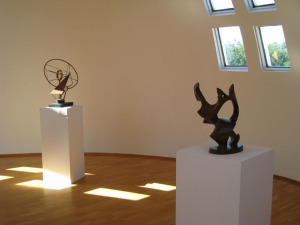Journey to Abstraction: “The Shape of a Line” at the Reykjavík Art Museum – Ásmundarsafn
Review and photos by Victoria Cross.
Ásmundarsafn is one of the most delightful museums in Reykjavik. Its collection isn’t trendy or edgy by modern standards, but the building itself, the sculpture garden around it and the pieces exhibited inside create a peaceful oasis in an otherwise ordinary neighborhood.
This branch of the Reykjavík Art Museum is devoted to the work of Ásmundur Sveinsson (1893 -1982), one of the most prominent Icelandic sculptors.
The building, located on Sigtún, is hard to miss. Its white dome, framed by two pyramid-like wings and the crescent-shaped gallery at the back command the viewer’s attention. Its outlines are especially striking against the blue sky.
Sveinsson, who worked and lived here, designed the building, inspired by Greek and Egyptian architecture. After his death, both the building and his collection of sculptures were donated to the City of Reykjavík.
View of the Museum.
The current exhibition of Sveinsson’s work, “The Shape of a Line,” concentrates on a period of his life during which he focused almost exclusively on abstract art. The earliest piece presented was made in 1947 and the latest in 1965.
If you consider in what year the house was built you will see that its construction dates back to the same period as Sveinsson’s exploration of abstraction.
The sculptor started the construction of the house in 1942 and its expansion continued into the beginning of the 1960s. Therefore, the building becomes not just a space for holding Sveinsson’s art work, but can itself be considered a part of the exhibition.
Interestingly, one statue doesn’t fit into this time frame. It is “The Water Bearer,” from 1937. For me it has come to represent the transition between Sveinsson’s figurative work and abstraction. One can clearly see the human shape, but all proportions are askew, the weight of the buckets strains the shoulders and pulls the arms toward the ground, creating an almost animal-like silhouette.
The heavy figure rooted in the ground presents a humble but powerful image. It isn’t surprising that when the sculpture was ready for installation, it caused controversy. The public viewed both the mundane matter and style as far too avant-garde.
“Water Bearer,” 1937-1938.
After the mid-1940s, when Sveinsson started to explore abstraction in his work, his art developed into two different styles. His carved pieces preserved some figurative features, but his iron and steel rod compositions evolved into pure abstraction.
The exhibition presents these two manners of abstraction side by side, angular and rounded shapes contrasting with each other, often in the space of one sculpture.
View at the exhibition hall.
My personal favorite is the “The Last Sea Voyage,” which is a perfect image of the upward movement of the waves carrying a ship. It has escaped one wave, yet a bigger one is gaining force and threatens to sink it.
“The Last Sea Voyage,” 1960.
Light is especially important for accentuating the form and modeling of sculptures. Sveinsson viewed the sculptor’s art as “taking material, forming it, and allowing the light to play with it.”
The airy space of the Ásmundarsafn museum—created by the sculptor with his own creations in mind—is perfect for showing off the exhibit. There is an organic connection between the light streaming from above, the pristine white walls, the placement of the windows and the ever-changing shadows.
Second floor: “The Face of the Sun,” 1961; “The Flash of Life,” 1950.
When observing Sveinsson’s work, one cannot help but wonder how a person born and raised on a remote farm (Kollstadir in west Iceland) in the late 19th century became interested in art.
Sveinsson couldn’t have seen many examples of Icelandic art; at the rise of the 20th century there were only three people in the country who chose art as their professional path—two painters, Thórarinn B. Thorláksson (1867-1924) and Ásgrímur Jónsson (1876-1950), and sculptor Einar Jónsson (1874-1954).
In fact, the first art exhibition ever held in Iceland was in 1900. Perhaps it was the magic world of Icelandic folklore that kindled Sveinsson’s imagination, a tapestry sewn by his mother or the craftsmanship of his father, who was a carpenter.
Whatever the reason, in 1915 Sveinsson left his home and launched his journey into art. He first learnt woodcarving and then studied sculpture. This journey brought him to Reykjavík, then Denmark, Sweden and later France.
Sveinsson was taught by and became acquainted with the work of great sculptors, such as Carl Milles, Aristide Maillol, and Charles Despiau. Each of them had a great influence on the young artist and helped him in the search for his own style.
One of the earliest works of Sveinsson “The Kiss” is situated in the sculpture garden. He created it in 1924 when he was 29. Its subject, material and simple composition bring to mind the statues of antiquity.
“The Kiss”, 1924, fragment.
From that time on Sveinsson began a gradual movement toward abandoning the representational form. In the course of 20 years, human and animal figures start to disappear from his work, making room for abstract forms.
By the age of 50 the sculptor almost solely concentrated on abstract art. The “Shape of a Line” exhibition is a great opportunity to see the results of his journey to abstraction.
The “Shape of a Line” exhibition is on display until August 31.
www.artmuseum.is
Tel: (+354) 517-1290
Sigtúni, 105 Reykjavík
Ásmundarsafn is open daily
May-Sept. 10am-4pm
October-April 1pm-4pm
Free admission





